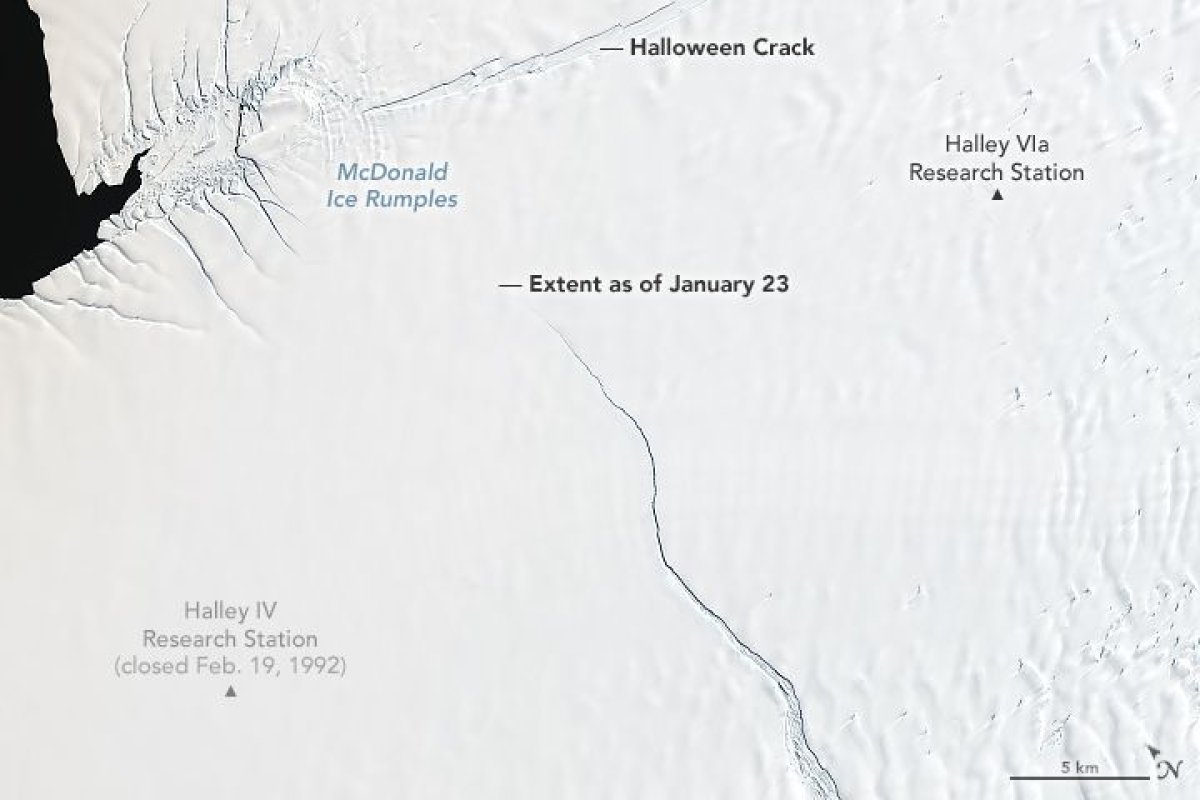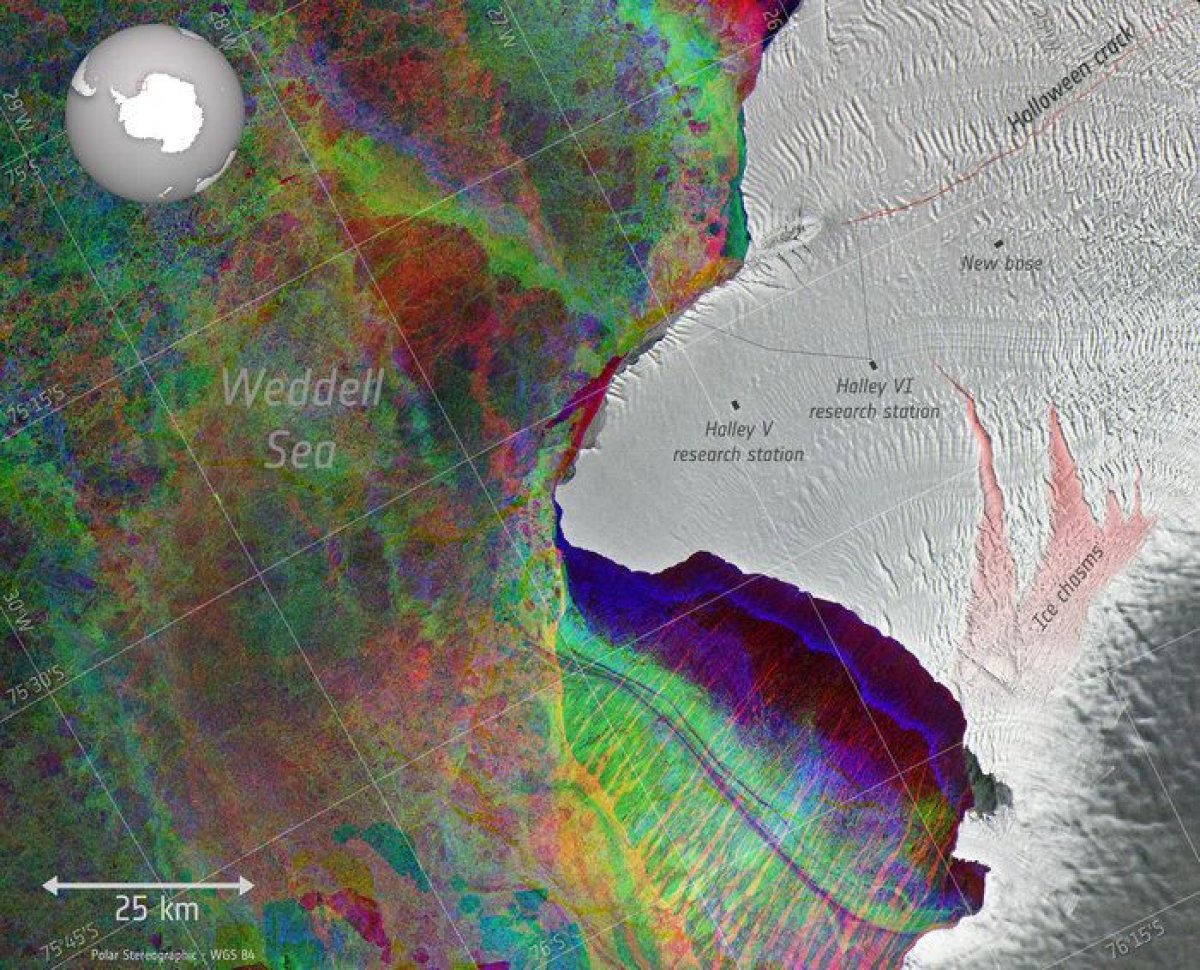An iceberg twice the size of New York City is about to break off Antarctica's Brunt Ice Shelf, NASA has said. Aerial images show huge cracks along the frozen landscape that have been growing since October 2016—when they meet, the outer ice will snap off and float away.
The Brunt Ice Shelf is a 400 foot-thick sheet of ice in the Weddell Sea. It is home to the British Halley Research Station, which in 2016 had to be relocated because of the huge chasm that appeared in the ice—now known as the Halloween Crack.
Since then, scientists have been closely monitoring the growth of the crack through satellite imagery—and NASA has now said it is the "countdown to calving," after another massive chasm started growing in the region.
Ice calving is where an iceberg breaks away from the edge of a larger body of ice. These events are a natural process that happens all the time. One recent event that made headlines globally was the calving of a Delaware-sized iceberg from the Larsen C ice shelf that broke away from the Antarctic Peninsula in 2017.
The latest calving event, however, is unusual. Nasa said the big concern is the rift that can be seen in the center of the image. Before the crack appeared, the region was generally thought of as stable—but this chasm has now been growing at a rate of around 2.5 miles per year.

The space agency said it is "not yet clear how the remaining ice shelf will respond following the break, posing an uncertain future for scientific infrastructure and a human presence on the shelf that was first established in 1955."
Images from the space agency's Operational Land Imager show how the crack has grown eastwards from an area dubbed the McDonald Ice Rumples. "The rumples are due to the way ice flows over an underwater formation, where the bedrock rises high enough to reach into the underside of the ice shelf," A NASA statement said. "This rocky formation impedes the flow of ice and causes pressure waves, crevasses, and rifts to form at the surface."
Joe MacGregor, a glaciologist at NASA's Goddard Space Flight Center, said what will happen at the Brunt Ice Shelf largely depends on where the rifts merge in relation to the Ice Rumples. "If they merge upstream (south) of the McDonald Ice Rumples, then it's possible that the ice shelf will be destabilized," he said in a statement.

The latest crack has led to concerns about the Halley Research Station, which is run by the British Antarctic Survey. Normally the base operates year-round, but the "unpredictable changes" to the ice has meant it has had to shut down twice over the last few years.
Chris Shuman, a glaciologist with NASA, said: "The likely future loss of the ice on the other side of the Halloween Crack suggests that more instability is possible, with associated risk to Halley VI."
A spokesperson from the BAS told Newsweek that the safety of its staff is the top priority and they are constantly monitoring the movement of the ice. "Our most recent (February 10) high-resolution synthetic aperture radar image showed that the rate of widening of the crack does appear to have increased since mid-January, but not enough to cause alarm," she said.
"The station is designed to be relocatable. In 2017 BAS successfully relocated the station's eight modules 23km (14 miles) upstream of a previously dormant ice chasm. The frequency of relocation depends very much on how the ice behaves in the future. Our long-term ice monitoring project is designed to alert us of any significant change in the ice."
This story has been updated to include quotes from the BAS.
Uncommon Knowledge
Newsweek is committed to challenging conventional wisdom and finding connections in the search for common ground.
Newsweek is committed to challenging conventional wisdom and finding connections in the search for common ground.
About the writer
Hannah Osborne is Nesweek's Science Editor, based in London, UK. Hannah joined Newsweek in 2017 from IBTimes UK. She is ... Read more
To read how Newsweek uses AI as a newsroom tool, Click here.








